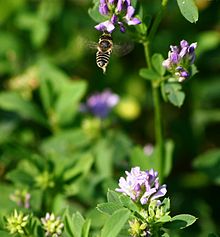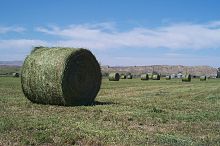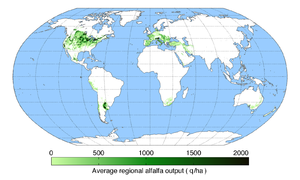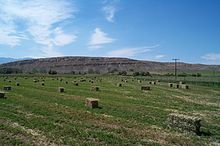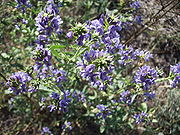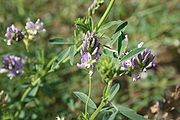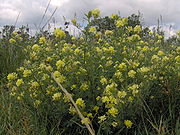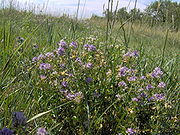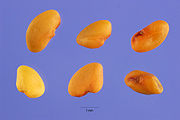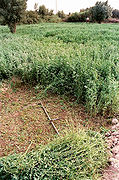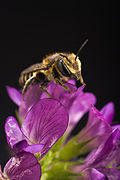- Alfalfa
-
This article is about plant and flower. For the actor and character of the series Our Gang, see Carl "Alfalfa" Switzer. For the community in Central Oregon, see Alfalfa, Oregon.
Alfalfa 
Medicago sativa Scientific classification Kingdom: Plantae (unranked): Angiosperms (unranked): Eudicots (unranked): Rosids Order: Fabales Family: Fabaceae Genus: Medicago Species: M. sativa Binomial name Medicago sativa
L.[1]Subspecies Medicago sativa subsp. ambigua (Trautv.) Tutin
Medicago sativa subsp. microcarpa Urban
Medicago sativa subsp. sativa L.
Medicago sativa subsp. varia (T. Martyn) Arcang.Alfalfa (
 /ælˈfælfə/; Medicago sativa) is a flowering plant in the pea family Fabaceae cultivated as an important forage crop in the US, Canada, Argentina, France, Australia, the Middle East, South Africa, and many other countries. It is known as lucerne in the UK, France, Australia, South Africa and New Zealand, and known as lucerne grass in south Asia. It superficially resembles clover, with clusters of small purple flowers.
/ælˈfælfə/; Medicago sativa) is a flowering plant in the pea family Fabaceae cultivated as an important forage crop in the US, Canada, Argentina, France, Australia, the Middle East, South Africa, and many other countries. It is known as lucerne in the UK, France, Australia, South Africa and New Zealand, and known as lucerne grass in south Asia. It superficially resembles clover, with clusters of small purple flowers.Contents
Ecology
Alfalfa is a perennial forage legume which normally lives 4–8 years, but can live more than twenty years, depending on variety and climate.[2] The plant grows to a height of up to 1 metre (3 ft), and has a deep root system, sometimes stretching more than 15 metres (49 ft).[2] This makes it very resilient, especially to droughts.[2] It has a tetraploid genome.[3]
Alfalfa is a small seeded crop, and has a slowly-growing seedling, but after several months of establishment, forms a tough 'crown' at the top of the root system. This crown contains many shoot buds that enables alfalfa to re-grow many times after being grazed or harvested.
This plant exhibits autotoxicity, which means it is difficult for alfalfa seed to grow in existing stands of alfalfa.[4] Therefore, it is recommended that alfalfa fields be rotated with other species (for example, corn or wheat) before reseeding.[5]
Culture
Alfalfa is widely grown throughout the world as forage for cattle, and is most often harvested as hay, but can also be made into silage, grazed, or fed as greenchop.[6] Alfalfa usually has the highest feeding value of all common hay crops. It is used less frequently as pasture.[5] When grown on soils where it is well-adapted, alfalfa is often the highest yielding forage plant, but its primary benefit is the combination of high yield per hectare and high nutritional quality.[7]
Its primary use is as feed for high producing dairy cows—because of its high protein content and highly digestible fiber—and secondarily for beef cattle, horses, sheep, and goats.[8][9] Humans also eat alfalfa sprouts in salads and sandwiches.[10][11] Dehydrated alfalfa leaf is commercially available as a dietary supplement in several forms, such as tablets, powders and tea.[12] Alfalfa is believed by some to be a galactagogue, a substance that induces lactation.[13] Alfalfa can cause bloating in livestock, care must be taken with livestock grazing on alfalfa because of its high bloat hazard.[14]
Like other legumes, its root nodules contain bacteria, Sinorhizobium meliloti, with the ability to fix nitrogen, producing a high-protein feed regardless of available nitrogen in the soil.[15] Its nitrogen-fixing abilities (which increases soil nitrogen) and its use as an animal feed greatly improved agricultural efficiency.[16][17]
Alfalfa can be sown in spring or fall, and does best on well-drained soils with a neutral pH of 6.8 – 7.5.[18][19] Alfalfa requires sustained levels of potassium and phosphorus to grow well.[20] It is moderately sensitive to salt levels in both the soil and in irrigation water, although it continues to be grown in the arid southwestern United States, where salinity is an emerging issue.[21][22][23] Soils low in fertility should be fertilized with manure or a chemical fertilizer, but correction of pH is particularly important.[24] Usually a seeding rate of 13 – 20 kg/hectare (12 – 25 lb/acre) is recommended, with differences based upon region, soil type, and seeding method.[25] A nurse crop is sometimes used, particularly for spring plantings, to reduce weed problems and soil erosion, but can lead to competition for light, water and nutrients.[26]
In most climates, alfalfa is cut three to four times a year, but it can be harvested up to 12 times per year in Arizona and southern California.[27][28] Total yields are typically around 8 tonnes per hectare (4 short tons per acre) in temperate environments, but yields have been recorded up to 20 t/ha (16 short tons per acre).[28] Yields vary with region, weather, and the crop's stage of maturity when cut. Later cuttings improve yield, but with reduced nutritional content.[29]
Alfalfa is considered an insectary due to the large number of insects it attracts.[30] Some pests, such as alfalfa weevil, aphids, armyworms, and the potato leafhopper, can reduce alfalfa yields dramatically, particularly with the second cutting when weather is warmest.[31] Chemical controls are sometimes used to prevent this.[31] Alfalfa is also susceptible to root rots, including Phytophthora, Rhizoctonia, and Texas root rot.[32][33][34]
Main article: List of alfalfa diseasesHarvesting
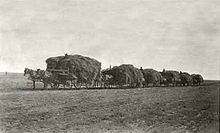 Alfalfa hay on the way to Clayton, New Mexico, circa 1915.
Alfalfa hay on the way to Clayton, New Mexico, circa 1915.
When alfalfa is to be used as hay, it is usually cut and baled.[35] Loose haystacks are still used in some areas, but bales are easier for use in transportation, storage and feed.[36] Ideally, the first cutting should be taken at the bud stage, and the subsequent cuttings just as the field is beginning to flower, or one tenth bloom for the reason that carbohydrates are at their highest.[37] When using farm equipment rather than hand-harvesting, a swather cuts the alfalfa and arranges it in windrows.[38] In areas where the alfalfa does not immediately dry out on its own, a machine known as a mower-conditioner is used to cut the hay.[35] The mower-conditioner has a set of rollers or flails that crimp and break the stems as they pass through the mower, making the alfalfa dry faster.[39] After the alfalfa has dried, a tractor pulling a baler collects the hay into bales.
There are several types of bales commonly used for alfalfa. For small animals and individual horses, the alfalfa is baled into small two-string bales, commonly named by the strands of string used to wrap it. Other bale sizes are three-string, and so on up to half-ton (six-string) "square" bales – actually rectangular, and typically about 40 x 45 x 100 cm (14 in x 18 in x 38 in).[3] Small square bales weigh from 25 – 30 kg (50 – 70 pounds) depending on moisture, and can be easily hand separated into "flakes". Cattle ranches use large round bales, typically 1.4 to 1.8 m (4 to 6 feet) in diameter and weighing from 500 to 1,000 kg, (1000 to 2000 lbs). These bales can be placed in stable stacks or in large feeders for herds of horses, or unrolled on the ground for large herds of cattle.[3] The bales can be loaded and stacked with a tractor using a spike, known as a bale spear, that pierces the center of the bale,[40] or they can be handled with a grapple (claw) on the tractor's front-end loader. A more recent innovation is large "square" bales, roughly the same proportions as the small squares, but much larger. The bale size was set so stacks would fit perfectly on a large flatbed truck. These are more common in the western United States.
When used as feed for dairy cattle, alfalfa is often made into haylage by a process known as ensiling.[8] Rather than drying it to make dry hay, the alfalfa is chopped finely and fermented in silos, trenches, or bags, anywhere the oxygen supply can be limited to promote fermentation.[41] The anaerobic fermentation of alfalfa allows it to retain high nutrient levels similar to those of fresh forage, and is also more palatable to dairy cattle than dry hay.[42] In many cases, alfalfa silage is inoculated with different strains of microorganisms to improve the fermentation quality and aerobic stability of the silage.[43]
Worldwide production
Alfalfa is the most cultivated forage legume in the world.[citation needed] Worldwide production was around 436 million tons in 2006.[44][page needed] The US is the largest alfalfa producer in the world, but considerable production is found in Canada, Argentina (primarily grazed), Southern Europe, Australia, South Africa, and the Middle East.[citation needed].
Within the United States, the leading alfalfa growing states are California, South Dakota, and Wisconsin. The upper Midwestern states account for about 50% of US production, the Northeastern states 10%, the Western states 40%, and the Southeastern states almost none. Alfalfa can be grown in the southern US states, but often leaf and root diseases and poor soils are limitations. Alfalfa has a wide range of adaptation, and can be grown from very cold northern plains to high mountain valleys, from rich temperate agricultural regions to Mediterranean climates and searing hot deserts.[citation needed]
Alfalfa and bees
Alfalfa seed production requires the presence of pollinators when the fields of alfalfa are in bloom.[3] Alfalfa pollination is somewhat problematic, however, because Western honey bees, the most commonly used pollinator, are not suitable for this purpose; the pollen-carrying keel of the alfalfa flower trips and strikes pollinating bees on the head, which helps transfer the pollen to the foraging bee.[3] Western honey bees, however, do not like being struck in the head repeatedly and learn to defeat this action by drawing nectar from the side of the flower. The bees thus collect the nectar, but carry no pollen and so do not pollinate the next flower they visit.[45] Because older, experienced bees do not pollinate alfalfa well, most pollination is accomplished by young bees that have not yet learned the trick of robbing the flower without tripping the head-knocking keel. When western honey bees are used to pollinate alfalfa, the beekeeper stocks the field at a very high rate to maximize the number of young bees.[45] Western honey bee colonies may suffer protein stress when working alfalfa only, due to shortage of one of the amino-acids comprising the pollen protein, iso-leucine. Today, the alfalfa leafcutter bee is increasingly used to circumvent these problems.[46] As a solitary but gregarious bee species, it does not build colonies or store honey, but is a very efficient pollinator of alfalfa flowers.[46] Nesting is in individual tunnels in wooden or plastic material, supplied by the alfalfa seed growers.[45] The leafcutter bees are used in the Pacific Northwest, while western honeybees dominate in California alfalfa seed production.[45]
A smaller amount of alfalfa produced for seed is pollinated by the alkali bee, mostly in the northwestern United States. It is cultured in special beds near the fields. These bees also have their own problems. They are not portable like honey bees, and when fields are planted in new areas, the bees take several seasons to build up.[45] Honey bees are still trucked to many of the fields at bloom time.
Varieties
Considerable research and development has been done with this important plant. Older cultivars such as 'Vernal' have been the standard for years, but many better public and private varieties better adapted to particular climates are available.[47] Private companies release many new varieties each year in the US.[48]
Most varieties go dormant in the fall, with reduced growth in response to low temperatures and shorter days.[48] 'Nondormant' varieties that grow through the winter are planted in long-seasoned environments such as Mexico, Arizona, and Southern California, whereas 'dormant' varieties are planted in the Upper Midwest, Canada, and the Northeast.[48] 'Nondormant' varieties can be higher yielding, but they are susceptible to winter-kill in cold climates and have poorer persistence.[48]
Most alfalfa cultivars contain genetic material from sickle medick (M. falcata), a wild variety of alfalfa that naturally hybridizes with M. sativa to produce sand lucerne (M. sativa ssp. varia). This species may bear either the purple flowers of alfalfa or the yellow of sickle medick, and is so called for its ready growth in sandy soil.[49]
Most of the improvements in alfalfa over the last decades have consisted of better disease resistance on poorly drained soils in wet years, better ability to overwinter in cold climates, and the production of more leaves. Multileaf alfalfa varieties have more than three leaflets per leaf, giving them greater nutritional content by weight because there is more leafy matter for the same amount of stem[citation needed].
Wisconsin and California and many other states publish alfalfa variety trial data. A complete listing of state variety testing data is provided by the North American Alfalfa Improvement Conference (NAAIC) State Listing as well as additional detailed alfalfa genetic and variety data published by NAAIC.
Genetically modified alfalfa
Roundup Ready alfalfa, a genetically modified variety was released by Forage Genetics Int'l in 2005. This was developed through the insertion of a gene owned by Monsanto Company that confers resistance to glyphosate, a broad-spectrum herbicide, also known as Roundup. Although most grassy and broadleaf plants, including ordinary alfalfa, are killed by Roundup, growers can spray fields of Roundup Ready alfalfa with the glyphosate herbicide and kill the weeds without harming the alfalfa crop.
Legal issues with Roundup Ready Alfalfa in the US
Roundup Ready alfalfa was sold in the United States from 2005–2007 with more than 300,000 acres (120,000 ha) planted out of 21,000,000 acres (8,500,000 ha). After a hiatus of nearly 4 years of legal and regulatory troubles, planting resumed in February 2011. In 2006, the Center for Food Safety and Geertson Seed Farm sued USDA-APHIS to stop farmers from growing Roundup Ready Alfalfa. Their primary claim was 1) the possibility of increased spread of glyphosate-resistant weeds, and 2) the possibility that gene flow from Roundup Ready alfalfa would harm organic or conventional growers. In early 2007, The 9th Circuit Court in San Francisco decided in favor of the plaintiffs, forcing USDA-APHIS to conduct an Environmental Impact Study—this study took four years and was completed in December 2010. At the same time, the California Northern District Court also issued an injunction order prohibiting farmers from planting Roundup Ready alfalfa until the US Department of Agriculture (USDA) completed its EIS study. As a result, the USDA put a hold on any further planting of Roundup Ready alfalfa from 2007–2011.
Monsanto subsequently sued Geertson Seed, a case that went to the US Supreme Court in 2010, and decided in favor of Monsanto (Monsanto Co. v. Geertson Seed Farms[50]).[51] In June 2010, the US Supreme Court issued a ruling on this matter in favor of Monsanto, and determined that the 9th Circuit should not have prohibited further plantings, but should have allowed USDA-APHIS to determine the safety of the technology. Both sides claimed victory.[52]
The final Environmental Impact Statement was issued by APHIS in December 2010, which found Roundup Ready Alfalfa to be safe for the environment. After a comment period, the crop was completely deregulated in January 2011 and planting resumed in February 2011. APHIS issued its lengthy EIS document and considered the gene flow issue, impacts on organic growers, the issue of Roundup-resistant weeds and host of other questions. In the end, it was determined that Roundup-ready did not present a risk to the environment (APHIS). A new lawsuit by the Center for Food Safety (and others) to stop further development of Roundup Ready alfalfa was filed against USDA-APHIS in March 2011.
History
A book on agriculture by the Roman writer Palladius, dated 4th century AD, includes a section about alfalfa. Palladius says: "One sow-down lasts ten years. The crop may be cut four or six times a year.... An [Roman] acre of it is abundantly sufficient for three horses all the year.... It may be given to cattle, but new provender is at first to be administered very sparingly, because it bloats up the cattle."[53] Palladius called alfalfa "medica", a name that referred to the Medes, a people who lived in ancient Iran. The ancient Greeks and Romans believed, very probably correctly, that the alfalfa plant came from the Medes land (in today's Iran). (The ancient Greeks and Romans also used the name medica to mean a citron fruit, once again because it was believed to have come from the Medes land). The ancient Roman name medica is the root of the modern scientific name for the alfalfa genus, Medicago. Despite the report in Palladius and in some other Roman and ancient Greek writers, there is little evidence that alfalfa was in widespread use in the Mediterranean region in those days.
The 13th century Arabic dictionary Lisan al-Arab says that "al-fiṣfiṣa" (alfalfa) is cultivated as an animal feed and consumed in both fresh and dried form.[54] In medieval Spain, the Arabic name "al-fisfisa" mutated into the Spanish name "alfalfa".[55] Alfalfa in medieval Spain was cultivated as fodder for horses and had a reputation as the best fodder for them. In the 16th century, Spanish colonizers introduced alfalfa to the Americas as fodder for their horses.[56] The English name "alfalfa" dates from mid-19th century far-west USA, from the Spanish. Alfalfa seeds were imported to California from Chile in the 1850s. That was the beginning of a rapid and extensive introduction of the crop over the western US States.[57] In the North American colonies of the eastern US back in the 18th century it was called "lucerne" and lots of trials at growing it were made, but generally without getting satisfactory results. Relatively very little alfalfa is grown in the eastern US still today. Today in France and Germany, and also in Britain and Australia, alfalfa is usually called "lucerne" | "luzerne", a word that arose in French in the 16th century. Since North and South America now produce a large part of the world's output, the word "alfalfa" has been slowly entering into other languages besides English and Spanish.
Phytoestrogens in alfalfa
Alfalfa, like other leguminous crops, is a known source of phytoestrogens,[58] including spinosterol.[59] Grazing on alfalfa has been suspected as a cause of reduced fertility in sheep.
Medical uses
Alfalfa has been used as an herbal medicine for over 1,500 years.[citation needed] Alfalfa is high in protein, calcium, plus other minerals, vitamins in the B group, vitamin C, vitamin D, vitamin E, and vitamin K.[60][61][62][63]
In early Chinese medicines, physicians used young alfalfa leaves to treat disorders related to the digestive tract and the kidneys.[citation needed] In Ayurvedic medicine, physicians used the leaves for treating poor digestion. They made a cooling poultice from the seeds for boils. At the time, alfalfa was also believed to be beneficial to people suffering from arthritis and water retention.[citation needed]
Gallery
Medicago sativaMedicago sativaMedicago sativaMedicago sativaFlowersYellow flowersLight violet flowersSeedsLucerne fieldBee on alfalfa flowerReferences
- ^ "Medicago sativa – ILDIS LegumeWeb". ildis.org. http://www.ildis.org/LegumeWeb?sciname=Medicago+sativa. Retrieved 7 March 2008.
- ^ a b c "alfalfa (plant) – Britannica Online Encyclopedia". Britannica.com. http://www.britannica.com/EBchecked/topic/14595/alfalfa. Retrieved 29 June 2011.
- ^ a b c d e http://ddr.nal.usda.gov/bitstream/10113/22014/1/IND23276500.pdf
- ^ "Understanding Autotoxicity in Alfalfa". Uwex.edu. http://www.uwex.edu/ces/forage/wfc/proceedings2001/understanding_autotoxicity_in_alfalfa.htm. Retrieved 29 June 2011.
- ^ a b http://www.kansasruralcenter.org/publications/alfalfa.pdf
- ^ http://www.caf.wvu.edu/~forage/library/forglvst/bulletins/salfalfa.pdf
- ^ http://www.uky.edu/Ag/AnimalSciences/pubs/id97.pdf
- ^ a b http://www.uaex.edu/Other_Areas/publications/PDF/FSA-4000.pdf
- ^ "HayUSA,INC. Premium Quality – Alfalfa". Hayusa.net. http://www.hayusa.net/alfalfa.html. Retrieved 29 June 2011.
- ^ Spottiswood, John. "Alfalfa sprouts". CookEatShare. http://cookeatshare.com/ingredients/alfalfa-sprouts. Retrieved 29 June 2011.
- ^ http://alfalfa.ucdavis.edu/IrrigatedAlfalfa/pdfs/UCAlfalfa8305Industrial_free.pdf
- ^ "Alfalfa: MedlinePlus Supplements". Nlm.nih.gov. http://www.nlm.nih.gov/medlineplus/druginfo/natural/patient-alfalfa.html. Retrieved 29 June 2011.
- ^ "E-News 6:14 – Herbs and Natural Remedies". Midwiferytoday.com. 14 August 2004. http://www.midwiferytoday.com/enews/enews0614.asp. Retrieved 29 June 2011.
- ^ Medicago Sativa (Alfalfa). Plantdex.com. Retrieved on 17 October 2011.
- ^ "Sinorhizobium meliloti genome home". Cmgm.stanford.edu. http://cmgm.stanford.edu/~mbarnett/genome.htm. Retrieved 29 June 2011.
- ^ https://portal.sciencesocieties.org/Downloads/pdf/B40724.pdf
- ^ http://alfalfa.ucdavis.edu/-files/pdf/alfalfaFactSheet.pdf
- ^ "UCANR Web Sites". Cestanislaus.ucdavis.edu. http://cestanislaus.ucdavis.edu/files/299.htm. Retrieved 29 June 2011.
- ^ http://forageresearch.tamu.edu/1985/CloverEstablishmentGrowth.pdf
- ^ http://www.ces.purdue.edu/extmedia/AY/AY-331-W.pdf
- ^ G4555 Managing Manure on Alfalfa Hay | University of Missouri Extension. Extension.missouri.edu. Retrieved on 17 October 2011.
- ^ http://water.usgs.gov/nawqa/studies/mrb/salinity_briefing_sheet.pdf
- ^ http://ag.arizona.edu/pubs/crops/az1129.pdf
- ^ Fertilizing Alfalfa in Minnesota. Extension.umn.edu. Retrieved on 17 October 2011.
- ^ Alfalfa seeding rates: how much is too much?. Uwex.edu. Retrieved on 17 October 2011.
- ^ MT200504.indd. (PDF) . Retrieved on 17 October 2011.
- ^ Alfalfa Cutting Height. Uwex.edu (9 April 1999). Retrieved on 17 October 2011.
- ^ a b [1][dead link]
- ^ Alfalfa: The High-Quality Hay for Horses. (PDF) . Retrieved on 17 October 2011.
- ^ ref.
- ^ a b Insect Pest Management on Alfalfa, FC-ENT-0031-00. Ohioline.osu.edu. Retrieved on 17 October 2011.
- ^ Phytophthora Root Rot of Alfalfa Key words: Plant Disease, Lucerne, black medic, birdsfoot trefoil, Phytophthora megasperma F. sp. medicaginis. Nu-distance.unl.edu (26 February 1997). Retrieved on 17 October 2011.
- ^ Rhizoctonia Root, Stem, and Crown Rot of Alfalfa AC-42-96. Ohioline.osu.edu. Retrieved on 17 October 2011.
- ^ http://pods.dasnr.okstate.edu/docushare/dsweb/Get/Document-2321/EPP-7621web.pdf
- ^ a b http://www.uaex.edu/Other_Areas/publications/PDF/FSA-2005.pdf
- ^ G4570 Reducing Losses when Feeding Hay to Beef Cattle | University of Missouri Extension. Extension.missouri.edu. Retrieved on 17 October 2011.
- ^ Alfalfa Management Guide—Harvest (3 of 3). (PDF) . Retrieved on 17 October 2011.
- ^ Hay harvesting by Self-Propelled Swather compared with mowing and raking. (PDF) . Retrieved on 17 October 2011.
- ^ hay mower-conditioner (agriculture) – Britannica Online Encyclopedia. Britannica.com. Retrieved on 17 October 2011.
- ^ http://www.washburncompany.com/
- ^ http://ucanr.org/alf_symp/1995/95-55.pdf
- ^ http://cals-cf.calsnet.arizona.edu/animsci/ansci/swnmc/papers/2005/Hartnell_SWNMC%20Proceedings%202005.pdf
- ^ http://www.extension.iastate.edu/Publications/PM417H.pdf
- ^ FAO, 2006. FAOSTAT-Food and Agriculture Organization of the United Nations. Faostat.fao.org. Retrieved on 17 October 2011.
- ^ a b c d e Milius, Susan (6 January 2007). "Most Bees Live Alone: No hives, no honey, but maybe help for crops". Science News 171 (1): 11–3. doi:10.1002/scin.2007.5591710110.
- ^ a b Alfalfa Leafcutter Bee in California. Pollination.com. Retrieved on 17 October 2011.
- ^ Alfalfa Variety Characteristics, AGF-014-92. Ohioline.osu.edu. Retrieved on 17 October 2011.
- ^ a b c d http://msuextension.org/publications/AgandNaturalResources/MT199303AG.pdf
- ^ Joseph Elwyn Wing, Alfalfa Farming in the U.S. 79 (Sanders Publishing Co. 1912).
- ^ Monsanto Company v. Geertson Seed Farms at ScotusWiki – Briefs and Documents, etc.
- ^ Hollow victory for Monsanto in alfalfa court case New Scientist, 22 June 2010 (accessed 22 June 2010)
- ^ Supreme Court on Modified Foods: Who Won? The Atlantic, by Barry Estabrook. 22 June 2010 (accessed 22 June 2010)
- ^ Links to online copies of the complete book Opus Agriculturae (aka De Re Rustica) by Palladius are listed at the foot of the Wikipedia article Rutilius Taurus Aemilianus Palladius.
- ^ The 13th century Arabic Lisan al-Arab dictionary is online at Baheth.info. Search for فصفصة in the dictionary. (The dictionary is also downloadable at Archive.org but that version doesn't have searchable text).
- ^ Discussed in French in Glossaire des mots espagnols et portugais dérivés de l'arabe by R. Dozy & W.H. Engelmann, published in 1869. Tersely summarized in English at ref and ref.
- ^ ref.
- ^ ref.
- ^ . PMID 7892287.
- ^ Natural Health Products Ingredients Database. Webprod.hc-sc.gc.ca (18 April 2007). Retrieved on 17 October 2011.
- ^ Nutrition Research Center, Alfalfa Nutritional Value. Nutritionresearchcenter.org (21 March 2008). Retrieved on 17 October 2011.
- ^ The Facts About Alfalfa, Melissa Kaplans' Herb Care. Anapsid.org. Retrieved on 17 October 2011.
- ^ "Alfalfa: The Father of All Foods". ALFALFA - A Discussion of Vitamin B-12 in The Vegetarian Diet.. http://curezone.com/forums/fm.asp?i=28092. Retrieved 2 November 2011.
- ^ Diamond, Marilyn (1990). The American Vegetarian Cookbook from the Fit For Life Kitchen. New York: Warner Books. pp. 379. ISBN 0-446-51561-2.
External links
Categories:- Medicago
- Forages
- Vegetables
- Arabic words and phrases
- Nitrogen-fixing crops
- Pollination management
- Substances used in homeopathy
- Plants described in 1753
Wikimedia Foundation. 2010.

